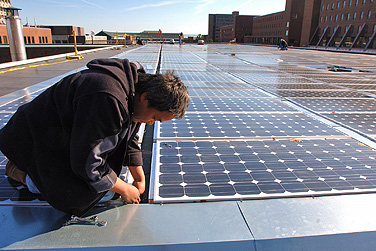UB named MAC environmental champion

A worker installs solar panels on the roof of Norton Hall. The system generates approximately 6 percent of the building’s annual electrical power consumption Photo: NANCY J. PARISI
UB has been named the 2009-10 Individual Conference Champion by the U.S. Environmental Protection Agency (EPA) for using more green power than any other school in the Mid-American Conference.
UB earned the honor by purchasing more than 16 million kilowatt-hours (kWh) of green power, representing 8 percent of the university’s annual electricity usage for 2009-10. The EPA estimates that UB’s purchase of green power is equivalent to carbon dioxide emissions from the electricity use of more than 1,000 average American homes each year, or has the equivalent impact of reducing the CO2 emissions of more than 2,000 passenger cars annually.
Since April 2006, the EPA’s Green Power Partnership has tracked and recognized the collegiate athletic conferences with the highest combined green power purchases in the nation. The Individual Conference Champion Award recognizes the school that has made the largest individual purchase of green power within a qualifying conference.
The EPA award underscores UB’s commitment to green initiatives and campus sustainability, says Robert G. Shibley, professor of architecture and planning, campus architect and senior point person for the development of UB’s comprehensive physical plan.
The push to achieve carbon neutrality—reducing or offsetting all of the university’s greenhouse gas emissions—was made an institutional priority when President John B. Simpson in March 2007 signed the American College and University Presidents Climate Commitment (ACUPCC).
This pact, now signed by the leaders of 685 institutions of higher education, required the signatories to make an inventory of current carbon emissions and, within two years, create a plan for making each of the campuses carbon neutral.
Since 2007, UB has decreased overall energy consumption by 11 percent and increased its consumption of renewable energy from 6 percent to 20 percent. UB also is the largest purchaser of wind power of any New York State agency and was the first campus in the SUNY system to buy a portion of its electrical power from a commercial supplier of wind, an in-state wind farm.
Today, environmental stewardship is a primary tenet of “Building UB,” the university’s master physical plan, Shibley notes. The plan to make UB a model 21st-century university proposes the creation of 7 million square feet of space to be constructed over a minimum of 20 years on UB’s three campuses. This requires making environmentally responsible structural and operational choices when building, Shibley says.
To meet the formidable goals of the ACUPCC, UB created the Environmental Stewardship Committee (ESC), which Shibley chairs, to address all facets of UB’s energy purchasing and consumption, including transportation, procurement, campus operations and capital construction. Six subcommittees were developed to provide support for these specific areas.
Michael F. Dupre, assistant vice president for university facilities and chair of the ESC energy subcommittee, explains that his division’s efforts to reduce energy consumption at UB date back to the late 1970s.
Through the efforts of UB Facilities, energy consumption at the university was less in 1987 than it was in 1982—even though the North Campus grew by 20 percent, or 775,000 square feet, with the construction of Alumni Arena, Bonner Hall, Computing Center, Jacobs Hall, Park Hall and the first phase of the Student Union. In 1996, University Facilities delivered an historic log of UB energy conservation—kept since the late 1970s—to the IRT Results Center, an independent research organization funded by a consortium of utility companies, to document successful demand-side, energy-management programs.
The IRT calculated that UB in 1996 had a cumulative energy savings of $65 million and an annual savings of $9 million.
According to Dupre, UB’s participation in ACUPCC raised the importance of campus-wide environmental sustainability to the level of institutional concern and brought UB’s senior leadership to the planning table to address environmental issues on UB’s three campuses.
Shibley says one of the keys to achieving the 11 percent decrease in UB’s energy consumption is making adjustments unit by unit and increasing the amount of renewable energy the university has been purchasing. But the single biggest factor is the ACUPCC endorsement, Shibley says.
“You make a commitment and work that commitment,” he explains.
Green may also be the “new black” in recruiting and engaging students. The Princeton Review recently added a sustainability component to its College Hopes and Worries Survey. In the survey for 2008, almost two thirds of respondents indicated they would value having information about a college’s commitment to the environment and that it might impact their decision about whether to attend that school.
Sustainability, reduced energy consumption, reduction in costs and student recruitment are all good reasons to continue our environmental initiatives, Shibley notes.

Reader Comments
Amanda Donohue says:
I agree with Michael to a major extent. Purchasing 8% of our energy in clean energy is by far better than none or than 5%, but it's time to put some ambition in our actions and really make a substantial portion of it clean and renewable. For the EPA to be so happy about 8% is kind of depressing to be honest. We need more than baby steps now, we need and we can do a lot better.
Posted by Amanda Donohue, Student, 06/14/10
Michael Lisieski says:
I think it's unfortunate that offsetting a relatively small proportion (8%) of UB's energy use makes us a leader in anything. What about the other 180 million-ish KWH of dirty electricity UB uses? What about the contribution of the hundreds (maybe thousands - I don't know the actual figures) of cars that drive to school and sit in UB's parking lots?
Not that UB's doing poorly, but there's much, much more left to do.
Posted by Michael Lisieski, Student, 06/13/10